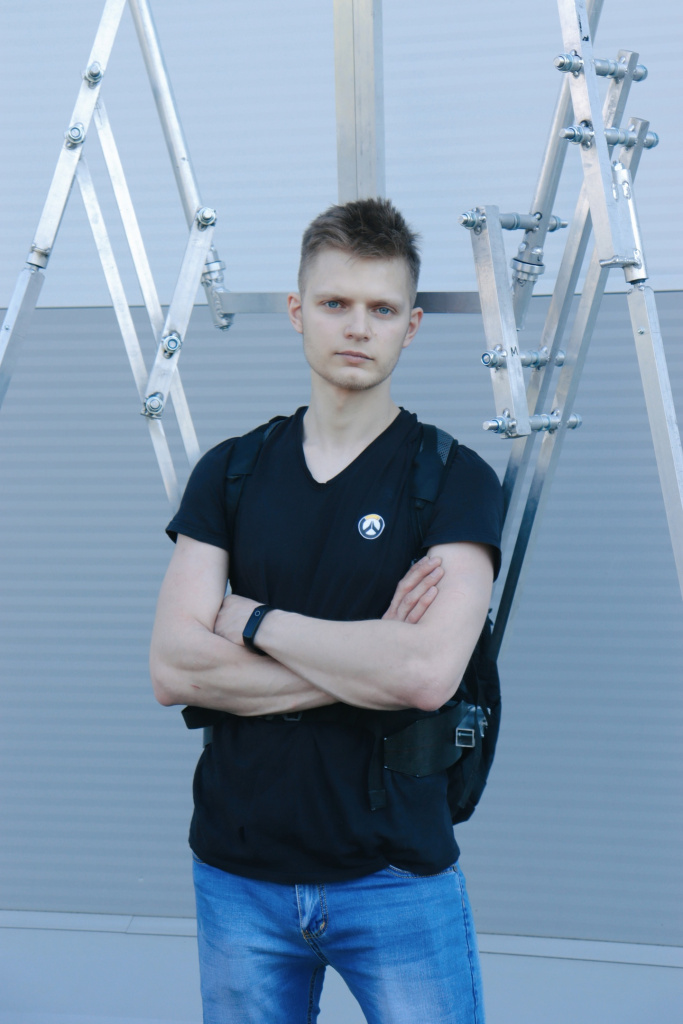 Yroslav Rochnyak wearing the exoskeleton
Yroslav Rochnyak wearing the exoskeletonYaroslav Rochnyak, Master's program graduate at the Faculty of Environmental Engineering and Municipal Services in the field of study Electric power engineering and electrical engineering, designed a working prototype of an exoskeleton - a device that enhances human movements. His thesis “Interaction of electromechanical and electrohydraulic systems in robotic structures” was carried out under the supervision of Associate Professor at the Department of Structural Physics, Power Engineering and Electrical Engineering Aleksandr Epishkin.
– The defense went quite smoothly, the project received the excellent mark,” said Yaroslav.
– Perhaps it was partly due to the facr that the commission members rarely get to see a working prototype in person. The device is large, complex, and the part of it that I presented is almost complete. This is the top part of the device: the right and left “arms” and “back”. The upper part weighs 17.6 kilograms, the weight of one “arm” is 7.3 kilograms. In addition, the commission got acquainted with load calculations, connection diagrams and real controllers and batteries.
At the moment, this is a passive exoskeleton: only mechanics are involved. In the future, it will become active: each mobility circuit will be connected to the corresponding electric drives, and at the moment when the operator in the exoskeleton raises his hand, the sensor counts this movement. For example, the right mechanical joint has two electric drives, one for each mobility circuit, and when the operator’s hand moves, the sensors will “understand” what needs to be done and “help” in a certain period of time.
I intend to equip the exoskeleton with a control board that supplies signals from the power supply to the motors. At the same time, everything must remain mobile and ergonomic, which, of course, is not an easy task.
– How did you get the idea for such a development?
– From the moment I entered SPbGASU, I was attracted to projects related to creativity and engineering. At first years of my bachelor's studies I became interested in design and the practical study of mechanics and electrical engineering.
At that time, I was also interested in cosplay and in 2019, as part of the Russian team, I took part in Overwatch Cosplay Battle, an international cosplay competition. We did a great job of creating a robot 3.2 meters high and weighing 400 kilograms, for which we received the People's Choice Award.
So, I decided to develop the concept of an exoskeleton in which one could move freely, run, jump, while maintaining a “window” in the design for further improvement. For example, for installing drives that enhance human movements.
I would like to thank my supervisor Aleksandr Evgenievich Epishkin and Associate Professor at the Department of Structural Physics, Power Engineering and Electrical Engineering Dmitry Vladimirovich Gorlatov. These are people who not only know their business, but are always happy to help students.
I am the only author of this development. I have not yet met practitioners like me, and this slows down the engineering of my prototype, since the work would go faster in a team. But working in a team requires investment, and I myself am the sponsor of my prototype. Therefore, development is carried out to the best of my ability, one might say, by enthusiasm.
I am a pioneer, and I had to assemble the exoskeleton from scratch. In Russia, only in 2022 did they begin to implement GOST standards to begin classifying exoskeletons and introducing certain requirements for devices and the safety of operators working with these devices. Of course, the concept of kinematic movement of such structures can be found on the Internet, but the closest analogue is assembled only in China. This concept is being developed in Russia for the first time.
– How do you manage your work?
– Ideas always come to me suddenly. Therefore, first I started making a physical version of the exoskeleton, and only then modeling it in the program.
I am modeling the prototype in the Autodesk Inventor environment, using 6061 aluminum as the frame material. In St Petersburg I look for suppliers of aluminum profiles (as a rule, these are AD31/D16T aluminum profiles) by myself and make components in my small workshop, after which I use the services of welders and turners.
I test the exoskeleton on the street, in open and not very crowded spaces. But those who see me, of course, cannot pass by and ask a lot of questions. Once I even interested the police: the exoskeleton looks quite impressive. Having learned that I was just a master's student testing my work, they told me that everything was fine and wished me good luck.
– Would you share your plans.
– Exoskeletons can be widely used in medicine, sports, and industry. My goal is to develop a prototype that suits me in terms of characteristics, which in the future could be modified for different tasks. Make it heavier but more powerful, or vice versa - lighter and more mobile. You can make it so convenient that a person, when using it, will practically not notice that he is receiving support for his physical efforts from such a device,” concluded Yaroslav.
We wish Yaroslav not to stop there, find like-minded people and successfully implement his project!